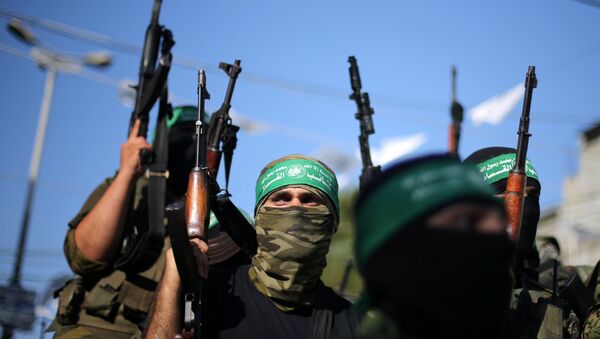Hamas has announced the beginning of the third "intifada" six days after US President Donald Trump announced the controversial decision to recognize Jerusalem as Israel's capital.
According to the Palestinian Islamic fundamentalist organization, which governs the Gaza Strip, it expects the "day of rage" protests against the US move, which claimed two lives and left over 1,000 injured on Friday, to continue.
"Protests will continue in the West Bank, the Gaza Strip and Jerusalem. Because we protest against the US recognition of Jerusalem as the capital of Israel, as we consider it the capital of Palestine. We hope that the protests will develop further and further," the movement's press secretary told RIA Novosti.
READ MORE: Israel Strikes Targets in Gaza as Hamas Calls for 'Intifada'
A day after Trump's announcement, which has been condemned by Muslim states and countries backing a two-state solution to the Israeli-Palestinian crisis, the leader of the political bureau of Hamas called for a third "intifada" uprising "against the US and Zionist plans to Judaize Jerusalem." Amid tense clashes between Palestinians and police over the US decision on Jerusalem, the Israeli army has intensified its operations against Hamas, particularly, targeting its tunnels in the Gaza Strip.
The previous intifada uprisings in 1987-1991 and 2000-2005 left hundreds of Israelis and thousands of Palestinians dead. The first Palestinian intifada was a Palestinian struggle against the Israeli occupation of the territories conquered during the 1967 Six-Day War, while the second uprising was provoked by visits of Israeli Prime Minister Ariel Sharon and a group of his supporters of the Temple Mount. While the second intifada had declined, the situation still has remained tense.
The First Intifada
Strictly 50 years ago, the wider world was stunned as Israel occupied the remaining Palestinian territories of the West Bank, East Jerusalem, Gaza Strip and even the Golan Heights in Syria in merely six days.
READ MORE: Israel's Army Reports About Rocket Fired From Syria at Golan Heights
In the following 20 years the Palestinians did not put up with Israeli dominance, which is when the uprising, otherwise dubbed the first intifada, started.
Amidst numerous Israeli settlements increasingly rising up on the historically Palestinian land, November 1987 saw the first revolt. The Palestinians were struggling, basically unarmed, throwing rocks at the Israeli troops.
The State of Palestine was proclaimed on November 15, 1988, in a session of the Palestinian National Council, the supreme PLO [Palestine Liberation Organization] governing body, which also recognized both the Arab and Jewish parts of Palestine providing Israel gave up claims over all territories it had occupied since 1967 and freed the land from its settlements. Back then, the PLO condemned terrorism in all its forms, thus paving the way for negotiating peace with Israel.
Early 1993 saw another round of talks held in secret in Oslo. The parties arrived at an agreement that was expected to end the PLO-Israel conflict. The 1993 agreement also stipulated the withdrawal of Israeli forces from the Gaza Strip and the West Bank and proclaimed a limited Palestinian National Authority. This time, the Palestinians withdrew their demand that the State of Israel should cease to exist.
The agreement was signed the same year in Washington, by Yasser Arafat, the then head of the PLO Executive Committee, and Yitzhak Rabin, the Israeli prime minister at the time. Israel and the PLO also signed an additional agreement, which recognized both entitiesas full-fledged negotiators.
The Second Intifada
No sooner had the Oslo agreement come into effect and Israeli withdrawals started, a number of hardline Israelis and Palestinians spoke out against it, pegging it a “sellout.”
This is where Hamas and the notion of the suicide bomber came in, leaving an estimated 1,000 Israelis dead in public places due to terrorist attacks and gunfire. Israel retaliated with airstrikes, causing approximately 3,000 deaths among the Palestinian civilians.
In July 2000, Bill Clinton summoned Yasser Arafat and Israeli Prime Minister Ehud Barak at Camp David, the presidential retreat in Maryland, but the contested status of Jerusalem and Palestine refugees brought the talks to a standstill.
Brought about by Sharon’s controversial visit to the historic Temple Mount in the city of Jerusalem on September 28, 2000, illegally occupied by the Israelis by then, the second intifada quickly grew into an open, deadly war. Its other name, Al-Aqsa Intifada, virtually refers to the original name of the Temple Mount, where the “shaking off,” or the intifada, started – Al-Aqsa Mosque.
READ MORE: Erdogan: Israel Seeks to Take Over Al-Aqsa Mosque Under Security Pretext
Yasser Arafat, an all-time Palestinian leader, died in a Paris hospital in November 2004. Earlier the Israeli Air Force eliminated Hamas leaders, including sheikh Ahmed Yassin and his successor Rantisi. Having lost its most high-profile figures, Hamas became demoralized to some extent and started operating locally.
The Sharm el-Sheikh Summit on February 8, 2005, is traditionally associated with the end of the second intifada, as Palestine President Mahmoud Abbas and Israeli Prime Minister Ariel Sharon concluded bilaterally that both parties would agree to a cease-fire. The upcoming Roadmap for Peace, initiated by the so-called Quartet on the Middle East – comprising the United States, the European Union, Russia and the United Nations – reiterated the aforementioned commitment, but with little effect, as violence still persisted.
In the wake of the second intifada, Israel, Canada, the United States and Japan condemned Hamas as a terrorist organization, while Australia and Britain slammed solely the military wing of Hamas. The movement is banned outright in Jordan. On December 17, 2014, the European General Court, a branch of the European Union's Court of Justice, ticked the Islamic Resistance Movement Hamas (Harakat al-Muqawama al-Islamiya) off its list of terrorist organizations.




